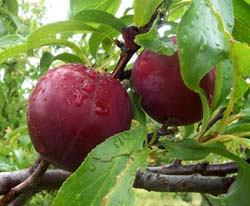What is important to consider when planting plum trees?
Two main things are important for good plum trees: soil that drains well and full sun exposure. If trees are located close to the south or west side of a building, they can also bloom too early in the spring and be damaged by frost. To avoid late-frost damage to blossoms in the spring, plant plum trees at the highest point of the property because frost will settle in low areas.
How reliable are plum trees?
In general, plums are considered one of the most dependable fruit producers in our area and produce a crop almost every year. Several European varieties that are reliable in our area include Stanley and Green Gage. Also, Blue Damson which is an early-bearing, small-fruited plum. Waneta is a late summer Japanese-American variety with large, red plums. Sapalta is considered one of the best to eat fresh from the tree but is also excellent for canning.
How many varieties of plums should I have?
 In most cases, two varieties of plums are needed to cross-pollinate each other. Japanese and European plums are grown in this area, but because of different bloom dates, they will not pollinate each other. Plant two different European plums or two different Japanese plums in a landscape to ensure a crop.
In most cases, two varieties of plums are needed to cross-pollinate each other. Japanese and European plums are grown in this area, but because of different bloom dates, they will not pollinate each other. Plant two different European plums or two different Japanese plums in a landscape to ensure a crop.
Which insects should I be on the look out for?
Plum trees are susceptible to peach tree borers and pear slugs, among others. Peach tree borers attack the lower part of the trunk. They can be controlled with pesticides applied to the lower trunk during the first part of July. Pear slugs are the larvae of sawflies. They suck juices from leaves, leaving only a skeleton. Dusting leaves with wood ashes will kill the larvae. These insects can also be controlled with almost any general purpose insecticide and your good care practices will help reduce pests and diseases.
For “Tree Borers” refer to message number 1417.
For more information, see the following Colorado State University Extension fact sheet(s).
- Pollination of Tree Fruits
- The Science of Planting Trees
- Pear Slugs
- Bacterial Wetwood
- Aphids on Shade Trees and Ornamentals
- Training and Pruning Fruit Trees



